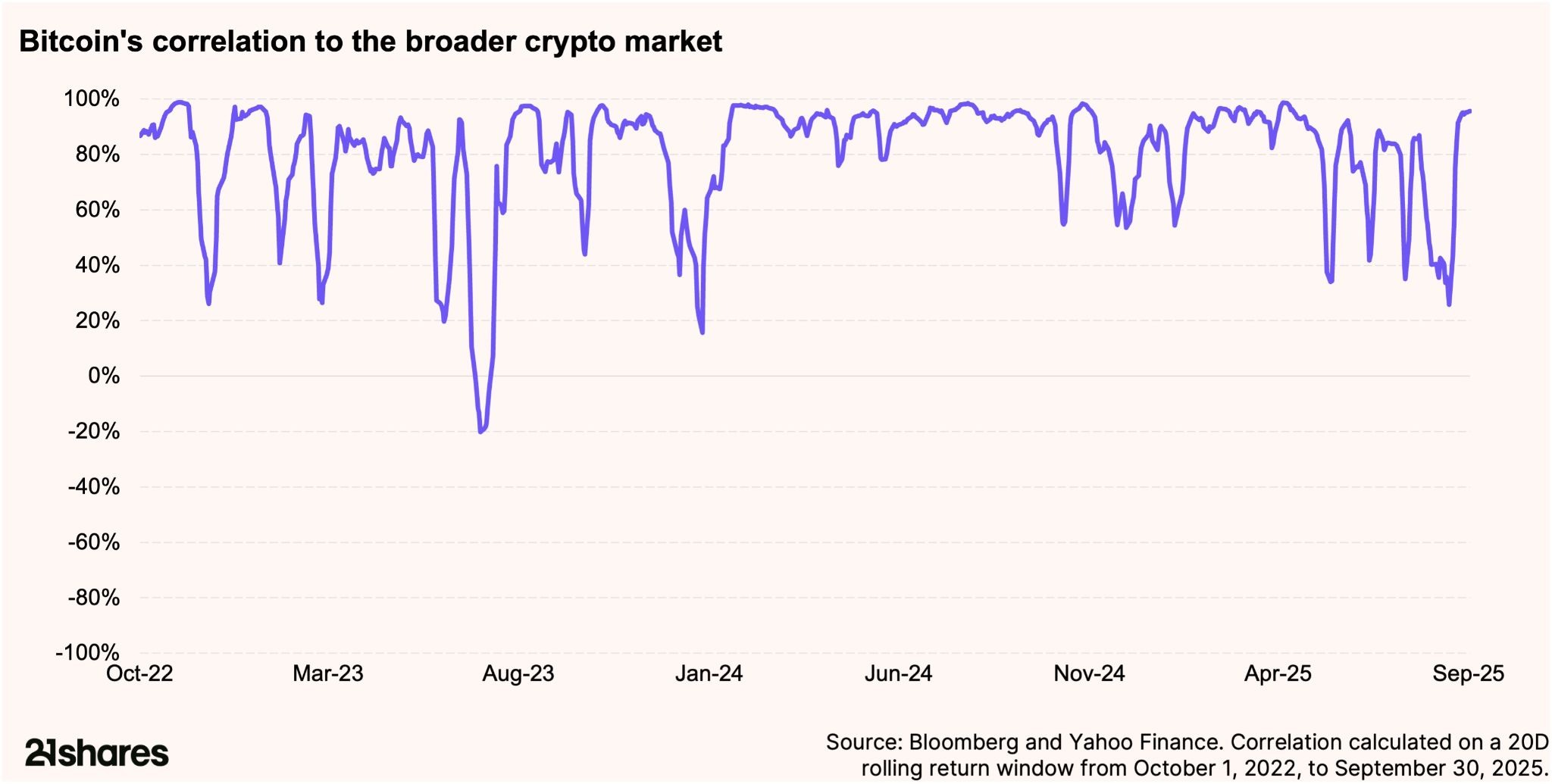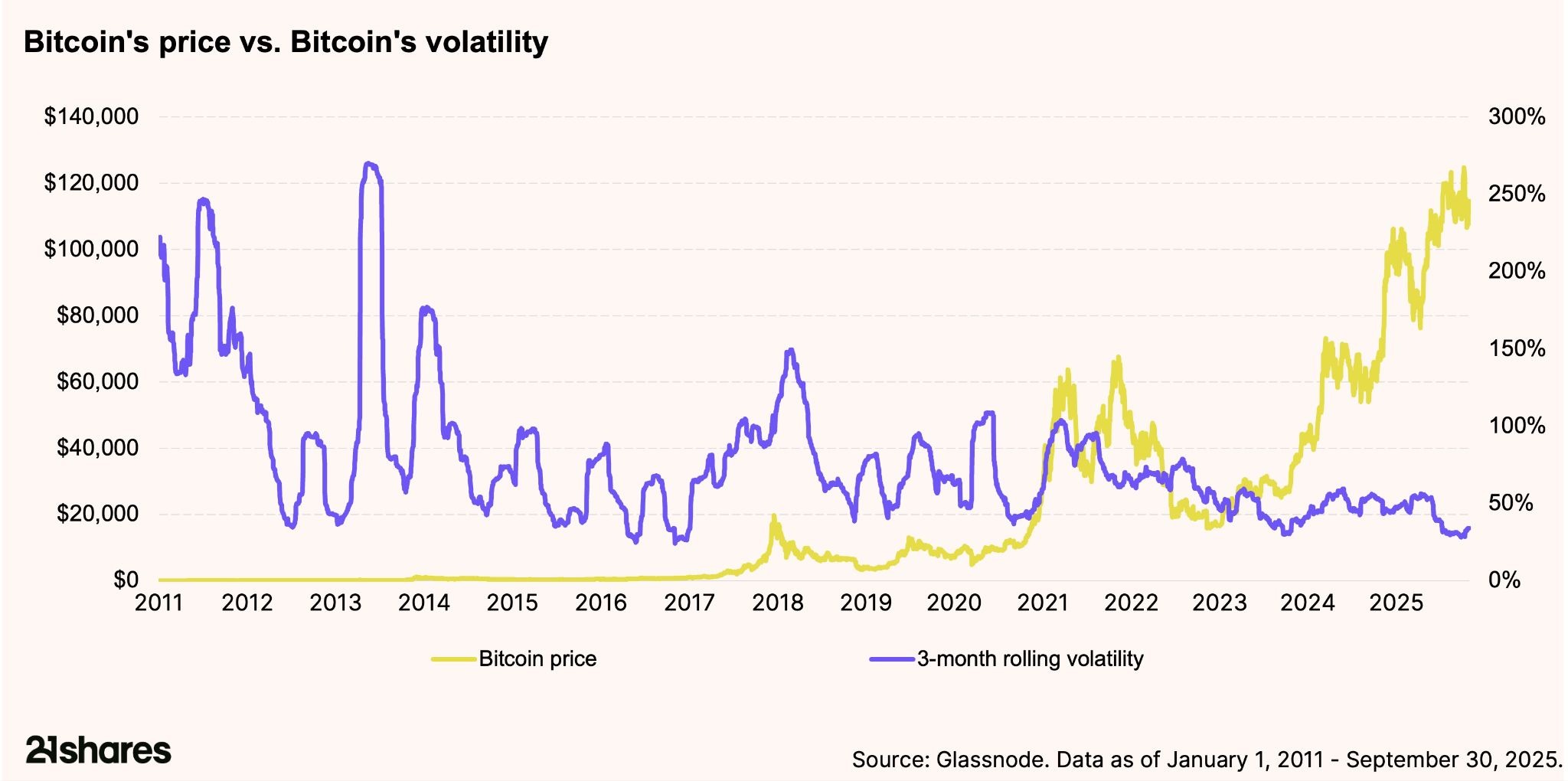How to add crypto to a portfolio?



Most investors assume crypto is too volatile or simply too niche to belong in a serious investment portfolio. This paper challenges that assumption. When allocating to any asset class, two key questions should be asked: What is the investment case for this asset? And more critically, what share of a portfolio, if any, should be allocated to it?
This primer focuses on the second. We apply a portfolio construction lens to digital assets to assess how they behave alongside traditional holdings like equities, bonds, and gold. Using correlation data and backtested allocations, we show that crypto is not only structurally different but also additive. When managed and sized appropriately, cryptoassets can enhance diversification, improve risk-adjusted returns, and introduce new sources of potential upside.
Correlation of returns across asset classes
Understanding how assets move relative to one another is a key input in portfolio construction. Correlation analysis helps determine whether a new addition to a portfolio amplifies existing risks or introduces meaningful diversification. In this section, we examine a broad set of traditional and digital assets to assess how crypto fits into a multi-asset allocation framework.
Over the full observation period from October 1, 2022, to September 30, 2025, Bitcoin, Ethereum, and the broader crypto market have exhibited consistently low correlations with traditional asset classes. This low correlation is a foundational reason why digital assets are increasingly considered within diversified portfolio frameworks.
Bitcoin’s average correlation with the rest of the asset universe sits at 30%, Ethereum at 31%, and the broader crypto market at 36%. These levels are meaningfully lower than internal correlations among traditional assets, which often cluster above 50%, especially among equities, bonds, and real estate.
Table 1: Correlation of Returns Across Asset Classes: October 1, 2022 - September 30, 2025

Source: 21shares, Data from Bloomberg and Yahoo Finance. Correlation calculated on a 10D rolling return window from October 1, 2022 to September 30, 2025.
For investors, this underscores the role of crypto not just as a source of potential returns but as an independent return stream. Cryptoassets behave materially differently than equities, fixed income, or commodities, and that differentiation introduces clear diversification benefits. However, to better understand how these relationships evolve and where cryptoassets diverge most meaningfully, it’s worth examining each in isolation over time.
Bitcoin: an emerging store of value with market regime sensitivity
Over the full period, Bitcoin has exhibited modest correlation with both traditional risk assets and defensive assets, around 9% with gold and 20% with US equities. Structurally, it shares many characteristics with traditional stores of value: finite supply, decentralized issuance free from counterparty risk, and censorship-resistance, which underpin its growing reputation as digital gold.
Over the long term, as global adoption deepens and volatility compresses, Bitcoin is expected to behave more like a traditional safe-haven asset, akin to gold. But today, it doesn’t fully mirror either end of the spectrum. Instead, Bitcoin occupies a unique middle ground, with tendencies that shift between risk-on and risk-off depending on the market environment.
This dual nature is clearly illustrated in the rolling correlation chart below, which tracks Bitcoin’s relationship to both equities and gold. At times, it trades like a growth asset; at others, it behaves defensively, and occasionally, decouples entirely.
This makes Bitcoin unlike any other asset in the market. It is structurally independent, behaviorally adaptive, and still offers significant asymmetric upside relative to legacy safe-haven assets. For portfolio construction, Bitcoin stands out as both a potential long-term hedge, and a high-impact diversifier at present.

Ethereum and broader crypto market: A frontier in digital innovation
Ethereum serves as the foundational layer for the crypto industry, enabling decentralized applications across finance, gaming, identity, and more. Similar to how iOS supports the mobile app ecosystem, Ethereum allows for a wide range of blockchain-native activity. As such, it's often compared to innovation-led sectors like tech.
However, correlation data suggests a more nuanced story. Over the full period, Ethereum’s correlation with US tech equities sits at 40%, and the broader crypto market sits at 45%. As the chart below shows, these assets don't move consistently with tech equities, despite being built on similar themes. Since the summer of 2025, we’ve witnessed a notable decoupling, particularly with Ethereum. This divergence has been fueled by strong regulatory tailwinds and renewed institutional interest, pushing Ethereum to new all-time highs and reaffirming its capacity to move independently based on idiosyncratic catalysts.
All in all, this reflects the distinct return drivers that shape crypto markets, such as protocol-level growth, token economics, and regulatory developments. Over time, we expect this decoupling to extend to the broader crypto market as well, although currently it remains somewhat tied to the broader risk-on environment regardless of its own return drivers. However, we anticipate that such decoupling will occur during momentary events, strengthening the case for including crypto alongside a tech sleeve, as it isn't entirely mirroring your exposure. As a result, crypto can offer a differentiated path to innovation exposure, with potential diversification benefits that go beyond what traditional tech holdings provide.

Internal crypto correlations: High but expected to decouple over time
Cryptoassets have historically moved in tandem, a hallmark of any nascent asset class. Shared liquidity flows, sentiment-driven moves, and synchronized responses to regulatory developments have kept correlations across the market elevated. Unsurprisingly, Bitcoin and Ethereum remain core anchors, with most of the crypto market still heavily tethered to their directional momentum.
Importantly, while Bitcoin and Ethereum still exert significant influence, we expect this influence to moderate over time. As use cases evolve, liquidity deepens, and new catalysts emerge, crypto markets are likely to shift toward more independent cycles, enabling more granular allocation strategies and selective exposure, similar to sector rotation in traditional equity markets.
The chart below reveals that shifting dynamic. While correlations remain high on average, we’ve observed increasingly frequent decoupling events, particularly over the past 12–18 months. Notably, in July 2023, Bitcoin briefly entered negative correlation territory with the broader market, and since then, similar dips have occurred with growing regularity, such as much of Q2 and Q3 of this year.
These episodes point to a maturing market, where specific narratives are beginning to drive differentiated performance. Specific assets are responding more to their own fundamentals than to Bitcoin’s gravitational pull. In short, the asset class is no longer moving as one monolithic unit. We are seeing the early signs of correlation breakdowns, which, if sustained, could strengthen the case for intra-crypto diversification based on unique value propositions.

Portfolio Analysis: understanding the impact of crypto allocations
To isolate the impact of crypto in a clear and relatable framework, we analyze its role in a traditional 60/40 equity-bond portfolio—a foundational allocation for many investors. This simplified model allows us to better illustrate how even a small allocation to cryptoassets, particularly Bitcoin, can affect portfolio performance, volatility, and risk-adjusted returns. We evaluate this through three key scenarios: a 1% Bitcoin allocation, 5% Bitcoin allocation, and a 5% allocation to top 5 cryptoassets, market cap weighted. These comparisons will help uncover how diversified crypto exposure—beyond Bitcoin—impacts portfolio construction, correlations, and risk-return tradeoffs.
Introducing Bitcoin to the model portfolio: the 1% test
To initially assess the impact of crypto to the portfolio, we introduced a 1% Bitcoin allocation, sourced from US equities (SPY) to reflect the reality that most new investors still largely see Bitcoin as a risk-on, growth asset. We tested this allocation across six rebalancing strategies to evaluate its effect on performance, volatility, and drawdowns.
Stronger Risk-Adjusted Returns: As shown in Table 2, adding just 1% Bitcoin improved both cumulative returns and Sharpe ratios across nearly all rebalancing frequencies. The benchmark portfolio returned 55.50% with a Sharpe ratio of 0.87. Portfolios with Bitcoin exposure reached as high as 62.93% in return and 0.93 on the Sharpe. Even at such a small weight, Bitcoin added meaningful upside and enhanced portfolio efficiency.
Table 2: Simple Growth Portfolio with a 1% BTC Allocation Across Different Rebalancing Strategies

Source: 21shares, Data from Bloomberg and Yahoo Finance from October 1, 2022 - September 30, 2025.
Volatility Remains Manageable: With a 1% Bitcoin allocation, portfolio volatility remained remarkably stable. Across all rebalancing strategies, annualized volatility ranged from 8.84% to 8.98%, while the non-rebalanced portfolio reached only 9.54%, a modest increase from the benchmark’s 8.85%. This shows that Bitcoin’s historical volatility doesn’t scale linearly at the portfolio level, especially when held as a small, diversified sleeve. Rather than amplifying risk, the 1% allocation often helped maintain overall volatility, especially when adequately rebalanced.
Well-Contained Downside Risk: A key concern with introducing new assets to a portfolio is whether they amplify downside risk. However, with a 1% allocation, Bitcoin did not meaningfully increase drawdowns. Across all strategies, maximum drawdowns remained in line with the benchmark, with the largest deviation just –1.88% in max relative drawdown. Notably, the quarterly rebalanced portfolio saw the smallest drawdowns at –11.21%, even lower than the benchmark. This reinforces a consistent message across our analysis: when properly sized and appropriately managed, Bitcoin can add value without materially increasing portfolio risk. It offers asymmetric upside potential while maintaining risk controls.
Scaling up: The 5% Bitcoin allocation
For investors looking to move beyond a minimal allocation and explore a more meaningful exposure to Bitcoin, we tested a 5% allocation to the model portfolio. The additional weight was sourced from US equities (3% from SPY) and bonds (2% from AGG), reflecting Bitcoin’s dual nature as both a risk-on and risk-off asset.
Table 3: Simple Growth Portfolio with a 5% BTC Allocation Across Different Rebalancing Strategies

Source: 21Shares, Data from Bloomberg and Yahoo Finance from October 1, 2022 - September 30, 2025.
Stronger Risk-Adjusted Returns: As shown in Table 3, increasing the Bitcoin allocation to 5% led to a material uplift in both returns and risk-adjusted performance. Cumulative returns jumped to a high of 80.10%, a gain of more than 24% compared to the benchmark. Sharpe ratios rose even more dramatically, reaching up to 1.07. This shows that expanding exposure beyond a minimal allocation doesn’t just boost absolute returns, it also strengthens portfolio efficiency.
Volatility Remains Manageable: Despite a larger allocation, volatility remained remarkably stable. Across all strategies, annualized volatility hovered between 9.20% and 10.53%, only marginally above the benchmark’s 8.85%, and still well within acceptable bounds for a traditional portfolio. This reinforces the point made in the 1% test: Bitcoin’s historical volatility doesn’t translate linearly to the portfolio level, especially when it’s a small sleeve in a diversified mix.
Well-Contained Downside Risk: A potential concern with increasing your Bitcoin allocation may be increased downside risk. However, as shown in the chart, even at a 5% allocation, maximum drawdowns remained tightly clustered across all strategies and stayed close to the benchmark’s –11.27%. The maximum relative drawdown remained modest, peaking at just –3.45%, indicating minimal degradation in downside behavior relative to the benchmark. This supports a key takeaway: a thoughtfully sized Bitcoin sleeve does not materially elevate drawdown risk. Instead, it offers the potential for outsized returns while maintaining a risk profile that remains within acceptable thresholds for diversified portfolios.
Diversifying further: 5% allocation to the broader crypto market
For investors looking to diversify beyond Bitcoin, we tested a 5% allocation to a market cap-weighted basket of the top five cryptoassets, including Bitcoin, Ethereum, Solana, and others as applicable. The allocation was sourced primarily from US equities (4% from SPY), as most of these assets are akin to high-growth investments, with the remaining 1% taken from bonds (AGG) to reflect the Bitcoin sleeve's dual nature as both a risk-on and risk-off asset.
Stronger Risk-Adjusted Returns: A 5% broader crypto allocation outperformed across all rebalancing strategies, with returns rising from 55.50% in the benchmark portfolio to as high as 75.98%, and Sharpe ratios improving from 0.87 to 1.07. Even when expanding beyond just Bitcoin, a modest, diversified crypto allocation provided a clear uplift in performance, reinforcing the role of broad-based exposure as a valuable addition to a balanced portfolio.
Volatility Remains Manageable: Stepping beyond Bitcoin to a 5% allocation in a diversified basket of top cryptoassets might seem like a step into higher risk, but the data tells a more balanced story. Despite the broader exposure, annualized volatility remained well-contained, ranging from 9.24% to 10.59%, only slightly above the benchmark’s 8.85%. Even the non-rebalanced portfolio, which delivered the highest return of 20.77%, exhibited a volatility of just 10.59%, a marginal increase with a notably better Sharpe Ratio of 1.01, versus the benchmark’s 0.87.
Well-Contained Downside Risk: Despite expanding to a 5% allocation in a diversified basket of top cryptoassets, downside risk remained remarkably well-managed. The benchmark portfolio experienced a maximum drawdown of –11.27%. In contrast, several of the crypto-allocated strategies recorded drawdowns close to this level, such as the daily and annual rebalanced portfolios at –12.19%. Even the worst-performing approach in terms of downside experienced a drawdown of –15.83%, only marginally larger than the benchmark, while offering significantly higher returns. This reinforces the idea that introducing broader crypto exposure does not have to come at the cost of significantly greater downside risk.
Table 4: Simple Growth Portfolio with a 5% Allocation to Top 5 Crypto Across Different Rebalancing Strategies

Source: 21shares, Data from Bloomberg and Yahoo Finance from October 1, 2022 - September 30, 2025.
Conclusion: volatility is falling, but price may not wait
Throughout this report, we’ve explored the role that cryptoassets can play within a multi-asset investment strategy. Across correlation analysis, crisis scenarios, and portfolio backtests, one message consistently emerged: modest crypto allocations have historically improved portfolio efficiency without meaningfully increasing risk. Small sleeves of 1–5% delivered improved returns, higher Sharpe ratios, and limited drawdown impact when structured and rebalanced appropriately. From a portfolio construction standpoint, the diversification case is empirical.
That said, crypto remains an evolving market, and every investment process involves more than just backtests. As always, past performance is not indicative of future results, and any allocation should reflect individual risk tolerance and investment goals.
That said, two trends are happening in real time: Bitcoin’s volatility is compressing, and its price is structurally rising. This pattern suggests a maturing asset class, one where the long-term opportunity may outweigh near-term hesitation. For investors still on the sidelines, the real trade-off may not just be volatility but opportunity cost. For those evaluating its role in a long-term strategy, the key question is shifting: not if to allocate, but when.

This report has been prepared and issued by 21Shares AG for publication globally. All information used in the publication of this report has been compiled from publicly available sources that are believed to be reliable, however, we do not guarantee the accuracy or completeness of this report. Crypto asset trading involves a high degree of risk. The crypto asset market is new to many and unproven and may have the potential not to grow as expected.
Currently, there is relatively small use of crypto assets in the retail and commercial marketplace in comparison to relatively large use by speculators, thus contributing to price volatility that could adversely affect an investment in crypto assets. In order to participate in the trading of crypto assets, you should be capable of evaluating the merits and risks of the investment and be able to bear the economic risk of losing your entire investment.
Nothing herein does or should be considered as an offer to buy or sell or solicitation to buy or invest in crypto assets or derivatives. This report is provided for information and research purposes only and should not be construed or presented as an offer or solicitation for any investment. The information provided does not constitute a prospectus or any offering and does not contain or constitute an offer to sell or solicit an offer to invest in any jurisdiction. The crypto assets or derivatives and/or any services contained or referred to herein may not be suitable for you and it is recommended that you consult an independent advisor. Nothing herein constitutes investment, legal, accounting or tax advice, or a representation that any investment or strategy is suitable or appropriate to your individual circumstances or otherwise constitutes a personal recommendation. Neither 21Shares AG nor any of its affiliates accept liability for loss arising from the use of the material presented or discussed herein.
Readers are cautioned that any forward-looking statements are not guarantees of future performance and involve risks and uncertainties and that actual results may differ materially from those in the forward-looking statements as a result of various factors. This report may contain or refer to material that is not directed to, or intended for distribution to or use by, any person or entity who is a citizen or resident of or located in any locality, state, country or other jurisdiction where such distribution, publication, availability or use would be contrary to law or regulation or which would subject 21Shares AG or any of its affiliates to any registration, affiliation, approval or licensing requirement within such jurisdiction.








_logo.svg)

.svg.png)